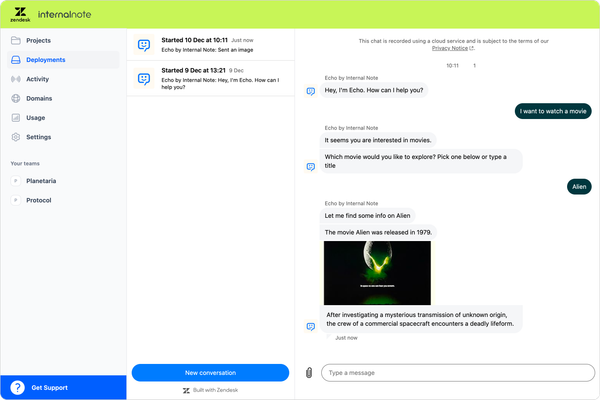
What's new from the Zendesk AI Summit 2025
Zendesk held its annual AI Summit in October, unveiling the next evolution of its Resolution Platform. This article explores every announcement and breaks down how AI Voice, Action Builder, Knowledge Builder, and new analytics shape the future of support across four major themes.
Earlier this week, Zendesk broadcast its yearly AI Summit as a live online event. showcasing their newest innovations. While Zendesk Relate is the major conference that sets the tone for the year, AI Summit has become the event where much of the vision presented at Relate comes to life.
Before we dive into the new announcements, it's important to set the scene. Zendesk has come a long way from being an email ticketing system a few guys in Denmark built on a door-desk.
Where Zendesk used to be a platform focused on agents handling tickets, doing it well, it evolved towards an omnichannel solution focusing on self-service later in its life. That self-service approach made it possible for teams to handle increasingly higher loads of customer requests, while retaining quality of both work and life for their agents.
With the advent of social media, a shift towards everything online and the proliferation of smartphones and an increasing sense of urgency, customer support has become a big part of any company's customer lifecycle. And as channel types and requests grew, so did Zendesk. It added more channels and allowed for smarter routing. It expanded ticket deflection with first chatbots, and now AI Agents. And it provided companies with deeper insights via Explore, and now QA and AI-powered insights.
But even though the platform grew, in essence it's still built for one job: to help customers find a solution for their problems. Those problems can come in the form of questions (how do I do this), personal context (where is my order?) or failure handling (something went wrong). The Zendesk Resolution Platform is there to help customers resolve all those inquiry types.

Regardless of what channel a customer chooses, at the topmost layer we still have a self-service approach, powered by your Help Center and AI Agents Essentials or Advanced. They pull from your knowledge sources, integrate with other tools, and follow procedures to try to automate as much of the conversation as possible.
If the conversation can't be answered or automated, we can route them to the right human team based on context like intent, language or other entities. Your human agents are there to handle those unique scenarios that either require a personal human touch, or the edge cases you didn't or couldn't account for in your processes. They are supported by Agent Copilot with its suggested replies, writing tools, and instructions. Agent Copilot is not there to replace your agents, but to make their life easier.
And at the end of the ticket lifecycle, Zendesk has QA and Analytics to give you insights on how your CX (or Employee Service) team is doing. Where Analytics gives you the numbers on what your team is doing doing based on SLA, CSAT and other metrics, QA gives you insights on how you're doing based on ticket content, sentiment and other metrics.
So, that's a short recap of the Zendesk Resolution Platform and sets the scene for this years' AI Summit.

Since Relate 2025 a lot of the then-announced features are now generally available to customers.
Every Zendesk customer now has access to Quick Answers in both the Help Center and Agent Workspace. AI Agents Essentials works across both Messaging Conversations and Email channels. App Builder just became available to everyone earlier this week. And Agent Copilot got instructions, macro support, and plenty of other powerful capabilities since Relate.
And while most, if not all of those releases focus on AI capabilities, Zendesk also deepened the platform with major improvements to brands and departments, added new security and privacy capabilities, and added support for attachments or images and better search and lookup field capabilities to custom objects.
These are just a few of the hundred of new features Zendesk released over the last few months. But while weekly released move the platform forward from a technical standpoint, events like this AI Summit focus not only on features, but also set a clear direction and focus for Customer Support and Employee Service teams.
Behind the scenes, Zendesk’s next generation of AI Agents is already taking shape. These new models go beyond prewritten flows or pattern-matching replies—they reason. Agentic AI lets Zendesk’s bots interpret context, make decisions, and follow multi-step procedures much like a human would. It’s the foundation that turns today’s automation into tomorrow’s autonomous resolution.
During the presentation, four clear themes emerged that capture the story of this event:
- Async to immediate
- Processes that span the ticket lifecycle
- Moving from building to instructing
- Widening the platform
Those four lines form a natural progression—moving from the rhythm of customer interactions, through the systems that sustain them, to the way we design and scale the platform itself.
Let’s start with the most fundamental transformation: how fast support can move.

Async to immediate
Before the advent of digital technology, customer care was a direct human relationship. People bought a service or good at a store, and if they needed support they went back to that store to complain. Your support relationship was direct and immediate. (Or if you asked for a manager, slightly delayed 😇).
Similarly, call centers and phone support were also immediate in their nature. You call a company, you pass the IVR and after a short or long waiting time you talked to a support person who helped you there and then. For customers, this was ideal. Their question would get resolved there and then.
But it also created problems. If many people called you'd get long waiting times. If the problem is complex you're put on hold, forwarded to another team or you might get called back. And for agents it requires immediate action and the need to know it all since they're the front line.
Email support, the next evolution in customer care took care of these issues. A customer emails their question, and the question could be internally forwarded to the right team, agents can research and resolve the issue for however long it takes, and the customer gets a resolution to their issue.
They're not put on hold, no one needs to act now and complex issues that take time can be resolved at that pace. But it also has its downsides. As a customer you need to wait. If your original email lacked context or crucial information, there's a new delay for both parties awaiting replies.
The next evolution once again resolved the previous versions' problems. Live chat gave that same sense of immediate support that phone support did. But instead of one agent talking to one customer, one agent could handle a few conversations, shifting from asking information to waiting for answers.
But similar to phone, you still had the problem of waiting. The customer needed to stay online for the duration of the conversation. If the issue couldn't be resolved you needed to shift from chat towards a promised follow up via email. Not ideal. But for those scenarios that can be solved here and now, it's way easier than email and scales better than phone.
Enter Messaging. This next step in conversations learns from social media and moves from live conversations towards asynchronous interactions. Similar to how you can message a friend and get a response later that evening, you can message a support team, your message enters a queue and they'll reply when an agent is available.
The entire conversation can happen async, with neither party needing to be online at the same time. It gives agents the working time email gives them, while giving customers a way to stay in touch and ask for updates in the same channel.
But where Messaging solved the delay problem by keeping a conversation live across a large time span, it does not solve the urgency problem. Customers that need a solution now, still need to wait for a human agent.
This is where AI Agents enter the room. AI Agents are scalable so they remove the queue. They can reply with tons of knowledge and can even automate processes. So they can resolve plenty of use cases. And more importantly, they remove work from agents' backlog, leaving them more time for the tickets an AI Agents can't (yet) resolve.
So AI Agents are ideal for immediate resolutions. They scale. They remove work from agents. They help customers when they have an issue. Problem solved, right?
Well, no. Because some issues are complex. They require a human for context, for approval, for, by lack of a better word, humanity. And while text-based channels like email or messaging are great for interacting with systems, the most efficient way for two people to communicate is still to talk to each other. Voice allows for nuance. For interruption. And seeing each other gives you even more context by getting those small visual queues from the person you're talking to.
And there's the contradiction. In the shift towards more efficient automation we moved away from the most effective channel because simply, it was not automatable at scale. IVRs only solved the routing problem but couldn't remove actual workload from agents.
And that's where the first big announcement of the AI Summit comes in. AI Agents for Voice.
Voice AI - AI Agents and Copilot
AI Agents for Voice act similar to the ones we have for Messaging.
When a customer calls your company the AI Agent greets the customer and asks how they can help. The customer states their problem, which triggers one of three scenarios.
Either the question can be answered based on knowledge. The system generates an answer and returns it to the customer in a generated spoken voice. If the question falls under a specific use case, similar to procedures in AI Agents Advanced, it'll ask for context (Can I have an order number?), pull information from external sources and return the spoken answer back to the customer.

And in scenarios where escalation to a human agent is needed, the AI Agent will ask for required information first, and route the conversation to the right agent based on the use case and intent. Agents will see a transcript of the interaction, and Agent Copilot will keep listening to the conversation, offering instructions and guidance right next to the ticket in Agent Workspace, using the same procedures Auto-Assist already uses for email and messaging tickets.
What's nice about this release is that it takes a channel that's inherently inefficient and turns it into a highly efficient one. Automatic resolutions take care of the biggest chunk of conversations.
Since the AI Agent understands the customer's contact reason, they can offer solutions during the call. They can route the customer to the right website, page or solution. They can look up delivery statuses, cancel orders, change bookings. And if they can't resolve the interaction, they can escalate some interactions to human agents with full context. And those agents can use the most efficient channel available to interact with customers: they can talk to them.
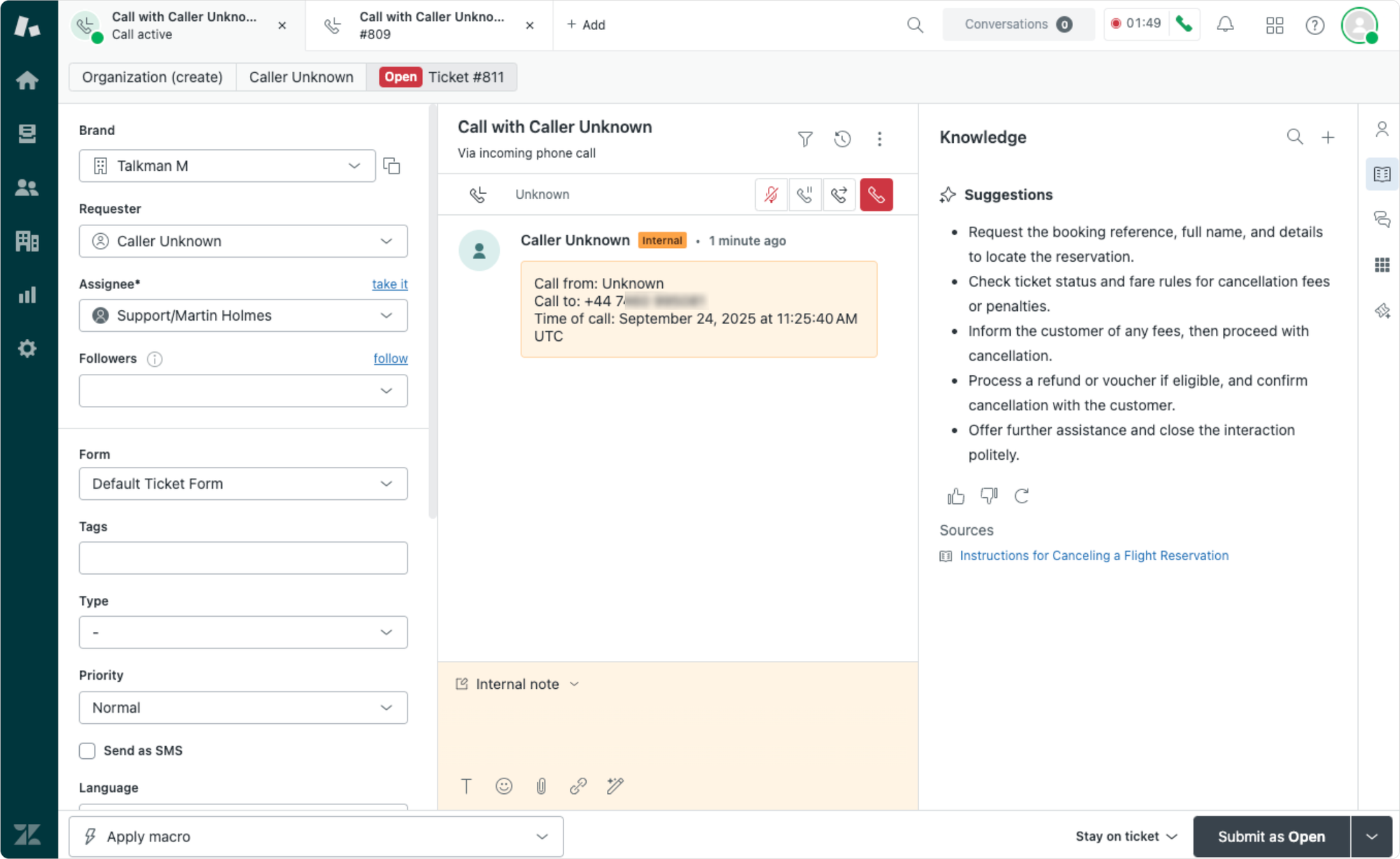
On the road towards immediate resolutions, I really see AI Agents for Voice as a potential game-changer. If these work as promised, I could see many companies revert back to phone as their primary human agent channel. Everyone will probably still offer social channels, messaging, email or web forms as the primary way to create tickets, but I can see more and more companies move towards offering voice as an escalation channel again.
Or, in scenarios where the question is highly unique and complex, our AI Agents can let the customer know this will need to be looked into, and a human agent will reach out to them later, regardless of the channel they contacted you from. Cause what's automatable can be resolved now, unique and complex is often async. And sometimes waiting is not a bad thing
AI Agents for Voice will be available in EAP in 2026. An initial version of Agent Copilot for Voice has been made available earlier this month for customers that have the Agent Copilot add-on.

Processes that span the ticket lifecycle
Design AI with the full customer journey in mind to scale for long-term success and beyond quick wins. - Georgia Bradbury-Adams - Motorway
A customer that reaches out to your team is just the beginning of the ticket lifecycle. To deliver proper support you need to map out the entire customer journey so you really know the different milestones in that process.
Zendesk's resolution platform offers most, if not all, features required to handle customer and employee support end-to-end.
We can basically split this into three parts:
- On the customer side we have the Knowledge Graph and procedures to start a conversation and hopefully resolve it
- On the agent side we have Omnichannel Routing and procedures to assign the conversation to the right person and assist them in handling or resolving the issue.
- On the company side we have QA, reporting and action builder flows to make what happens within the CX team available to the broader team, both in the form of insights and in the form of escalations to teams and tools.
Combined, these three follow a question through an entire process: A "Product Return" use case starts with customer inquiring about timings and options. Agents handle the return and make changes in external tools while agents follow instructions to execute, while actions automate steps and integrate with rest of the company.
On the customer side you can define procedures and actions for AI Agents to handle automatable inquiries. As a company you need to know which use cases you want your AI Agent to handle, how it should handle those and where it can find data to do so. The platform's agentic procedures, use case mapping, and actions allow you to define those processes right within the tool, no external services needed. (Except the platforms you want to pull data from).
When human agents are needed, Intelligent Triage's intents can be used to route tickets to the right team based on availability, skills and capacity. This gives you people and workload management within the platform.
Agent Copilot and its procedures, instructions and actions give agents a boost. Instead of them knowing the entire process to handle the customer inquiry, Agent Copilot offers them suggested replies, quick answers and even full instructions based on the procedures you define. And if additional data is needed, here, too Actions can pull in (or push) data to and from external platforms.
Processes don't end with your CX team though. Finance might need to handle complex refunds. Marketing or Development needs to be pulled in. Logistics might need to check a delivery. For those parts of the process that live outside of customer care, Action Builder allows you to integrate your wider company into Zendesk, and Knowledge Connectors expand the knowledge graph with data from tools like SharePoint or Confluence.
This way, Zendesk can handle the customer care process all the way from the channel the customer chooses up to internal teams finalizing the inquiry.
Action Builder
First up is Action Builder. Previewed at Relate earlier this year, Action Builder is Zendesk's built-in solution to Zapier. It allows you to build flows based on specific conditions that either update the ticket, or interact with external tools.
With Action Builder you can notify a specific Slack group if a VIP user contacts you. Or create a ticket in Jira, update or look up data in Salesforce, Shopify or plenty of other popular and built-in integrations.
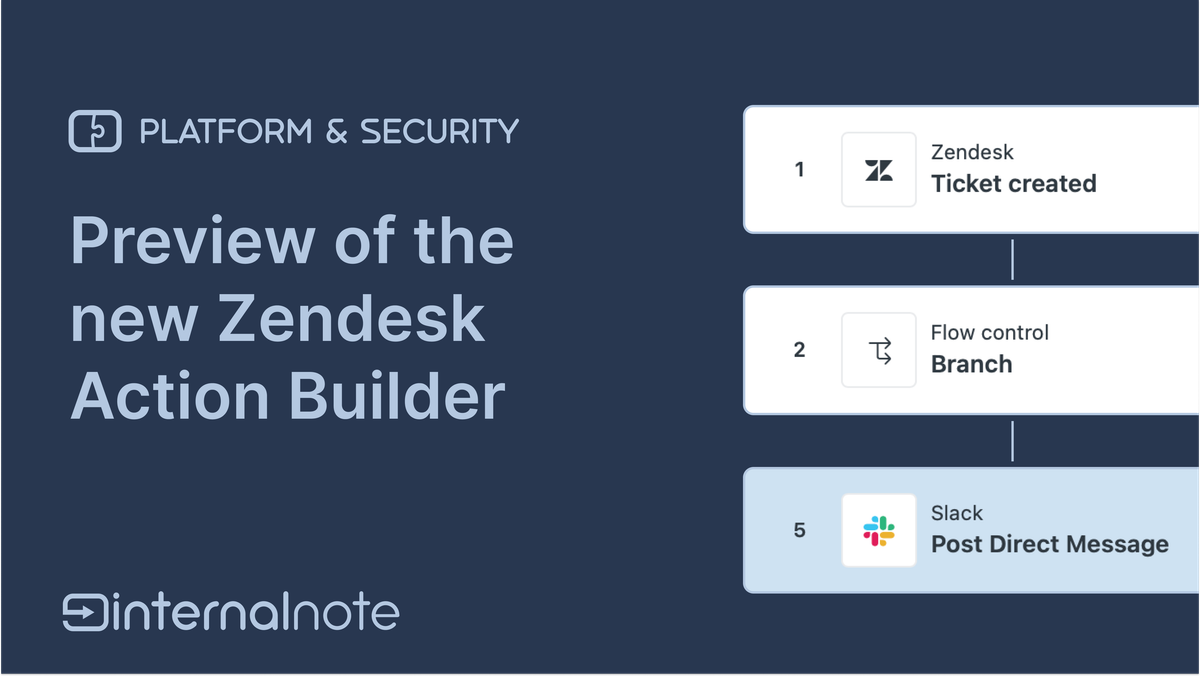
I wrote a full overview of Action Builder earlier this year
Within these native integrations there's one particular that has major potential, and that's the OpenAI integration. This allows you to prompt OpenAI, feed it text from a ticket or previous step, and have the LLM return generated text. You can use it to create custom summaries. Or turn the API data from another custom or native integration into readable text. You can derive context from a customer content and have the LLM output a customers' choice, which you can use in next steps.
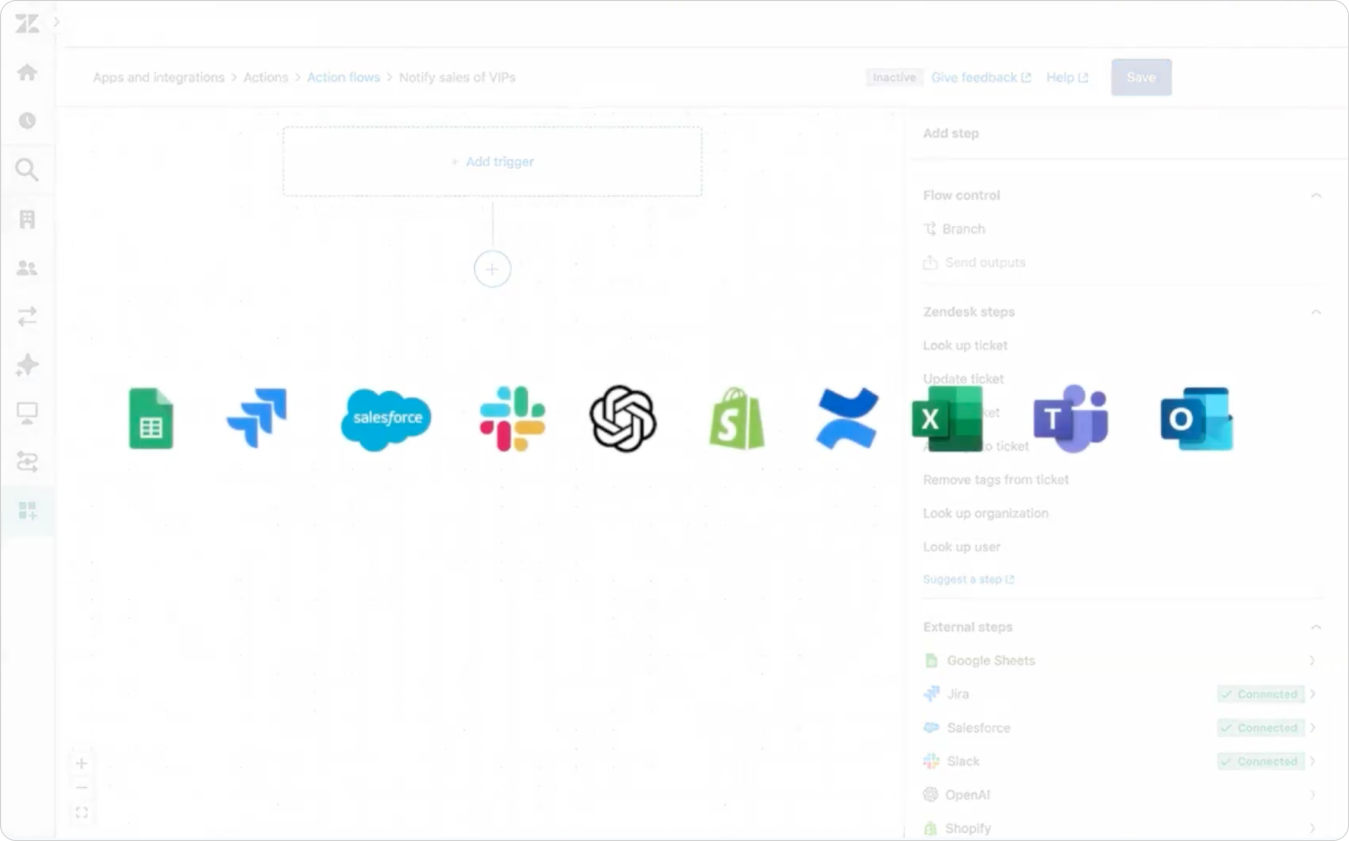
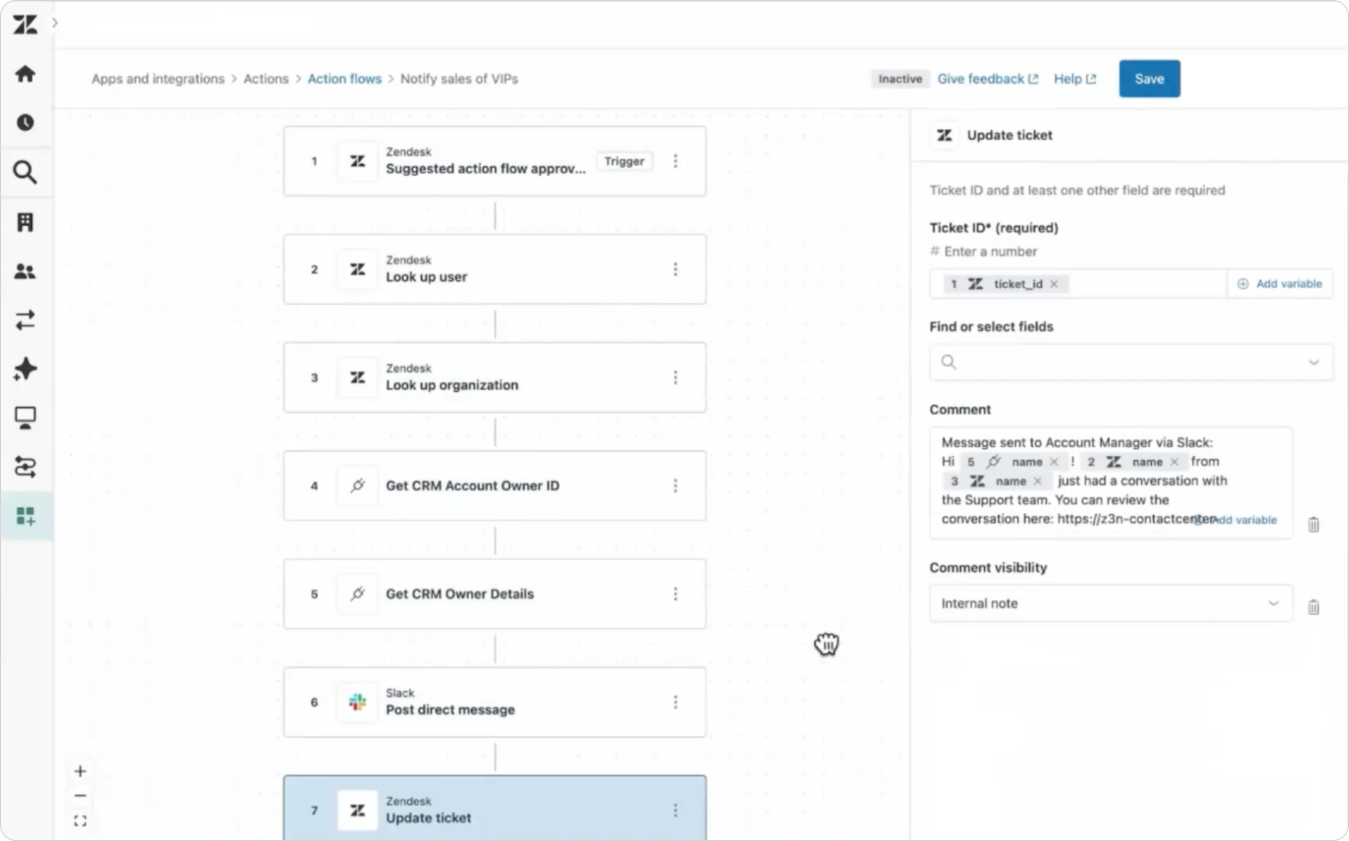
Action Builder's new actions
Even though Action Builder is still in EAP for now, at the AI Summit Zendesk announced it is available now to all, meaning it'll probably go out of EAP soon.
For me, Action Builder is the missing link at the end of the ticket journey—the point where support stops being a closed loop and starts feeding the rest of the company. When I first wrote about it, I called it “a better trigger system,” and that was only half right. Sure, it can tag, comment, and update like the best of them. But that’s not the point. Action Builder isn’t about tidying up workflows; it’s about wiring Zendesk into everything else you use. With its native and custom integrations, it turns ticket activity into company activity—making sure feedback, requests, and insights don’t die in a solved ticket but land where they can be fixed, measured, or turned into something better.
Knowledge Connectors
Procedure (noun) — “a series of steps followed in a regular, definite order; a particular way of accomplishing something or of acting.”
Procedures, or processes can only be followed if they are documented. Similarly, AI Agents need information in order to find answers and reply to customers.
Zendesk already offers a few tools to make sure knowledge is accessible to your agents and customers. For one, there's obviously the Help Center that allows you to publish support articles. There's also Federated Search and AI Agents' advanced capability to index public websites.
AI Agent Procedures contain the necessary information for agents (and Auto-Assist) to go through the steps to handle a specific use case. Specifically, the new instructions offer agents clear guidance on how to handle and execute certain steps manually, while procedures and actions give AI Agents the required steps to autonomously, or offer them to your human team.
But knowledge doesn't stop there. IT might have documented specific steps, documentation and processes in Confluence. Your finance or marketing team might use Sharepoint to share new campaigns or store customer contracts. And Google Drive probably contains dozens of internal spec sheets, presentations and meeting notes, all useful to resolve tickets.
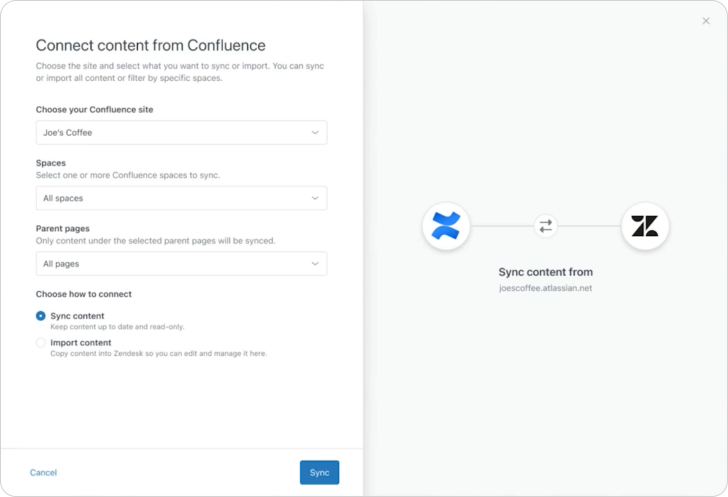
The new Knowledge Connectors bridge the gap between Zendesk and those other tools (and teams). They offer native integrations that allow you to link and index these tools and make them part of Zendesk's Knowledge Graph. We no longer need to resort to export/import, APIs and custom scripts to get data across tools is awesome.
Knowledge Connectors are available now, so I hope to get access to them soon and write about them!
Real-time monitoring
Where knowledge gives your team a tool to help resolve tickets, insights give your team the knowledge they need to keep improving their services.
Zendesk already has a rich and powerful reporting tool as part of its suite with Analytics (Explore) and QA. With the newly announced live dashboards and real-time monitoring, Zendesk takes its live dashboards and turns them to 11.
The new real-time monitoring lives in a new home page for the Analytics section of Zendesk, continuing a trend of making each element's Home Screen actionable. Agent Workspace gets Agent Home with active tickets. Admin Center gets the new Home Screen with useful insights and trends (see below), and AI Agents Advanced got a new overview of your Agents and their performance.
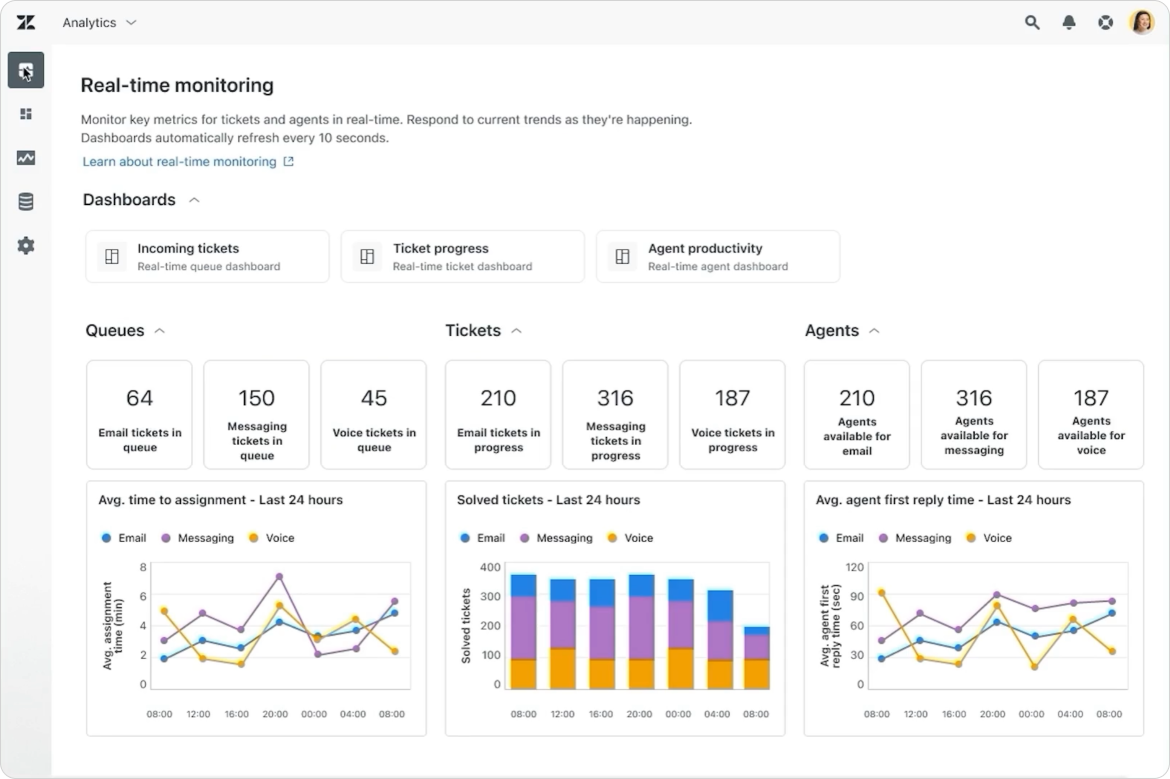
This new Analytics Home Screen shows your team live data on queue size, ticket backlog, agent capacity, with deep dives on each one of these. And since the data is live, these dashboards become actionable. A sudden spike in messaging tickets can be resolved by putting more agents online on that channel. Or a spike in payment failure intents might lead into an escalation and wake up call for your SysOps team.
Combining these analytics with the new real-time QA insights gives your team a deep understanding of what's going on with their tickets, making sure that tickets are not only resolved, but that the business also learns from these requests to improve services, processes and documentation.

Moving from building to instructing
The previous two themes really focused on how Zendesk makes resolving tickets easier and more efficient. AI can be used to automate ticket resolutions, and the platform itself scales across the entire ticket lifecycle, giving you the tools you need to optimize your ticket flows on every milestone in that journey.
This third theme shifts away from the actual resolution process, and focuses more on how we get there. If you've used Zendesk as long as I do, you will probably be familiar with the Admin Center and the ways we can set up the different elements that turn Zendesk into a tool that fits your company.
A good self-service strategy starts with documenting as much as possible so you have a good knowledge base customers can search and read. But as channel types grew, so did the need to modify knowledge to fit the channel. That means adding links to content in AI Agent flows, modifying content to fit in macros (or in a tweet), and using elements like dynamic content and translation services to make your content available across languages.
Where knowledge fails, dialogue flows take over. We all know the process of building out flowcharts with steps and conditionals to handle the different use cases our AI Agents need to handle. And these scenarios were originally trained with training phrases and example tickets.
But as AI tools evolved, their capabilities expanded and the cost to deploy them at scale lowered with models like GTP4o, something changed in the way we configure Zendesk.
We no longer need to manually rewrite content to fit the channel or customer. Generative replies, powered by your knowledge content and controlled with instructions and personae turn content you write once into a personal response in the right tone of voice, language and context of the customer.
Dialogue flows and use case training have evolved into descriptive processes. You describe a use case and its procedure, and the new Agentic models in AI Agents Advanced and Copilot will dynamically adapt and reason to guide the customer through the process.
And where we used to rely 100% on developers or the amazing Zendesk Partner ecosystem to integrate with tools and automate processes, tools like App Builder and custom actions lower that threshold and make custom integrations available to everyone. That is, as long as you can clearly describe your use case, understand your processes and ensure the data you want to access is available via API.
If we zoom out there's a clear trend here. We used to build and configure Zendesk by setting up triggers, define automations and craft flows by painstakingly filling in fields, selecting the right options and testing it. But thanks to AI we can describe what we need, and Zendesk takes these instructions and turns them into working processes and configurations.
Not only is this way faster than building it by hand, it also means that the person who owns or understands the process can be the person that sets up Zendesk. Which gives power to your team leads and CX agents to have an actual impact on their work environment.
During the AI Summit presentation, we saw a few new of these capabilities being added to the platform. Let's dive in.
Knowledge Builder
There's a lot of knowledge hidden within your tickets. Agents might use information they get from your other teams to answer a customer question. A customer might run into a specific problem which other customers might also encounter. Or an agent might find an error in an article.
Until now the only way to get that information in front of your customers is by flagging these tickets, and manually editing or writing the support articles.
If you're new to Zendesk migrating from another tool, or if you're a startup who just made the jump from a shared mailbox into a proper customer support platform, you might not even have a Help Center.
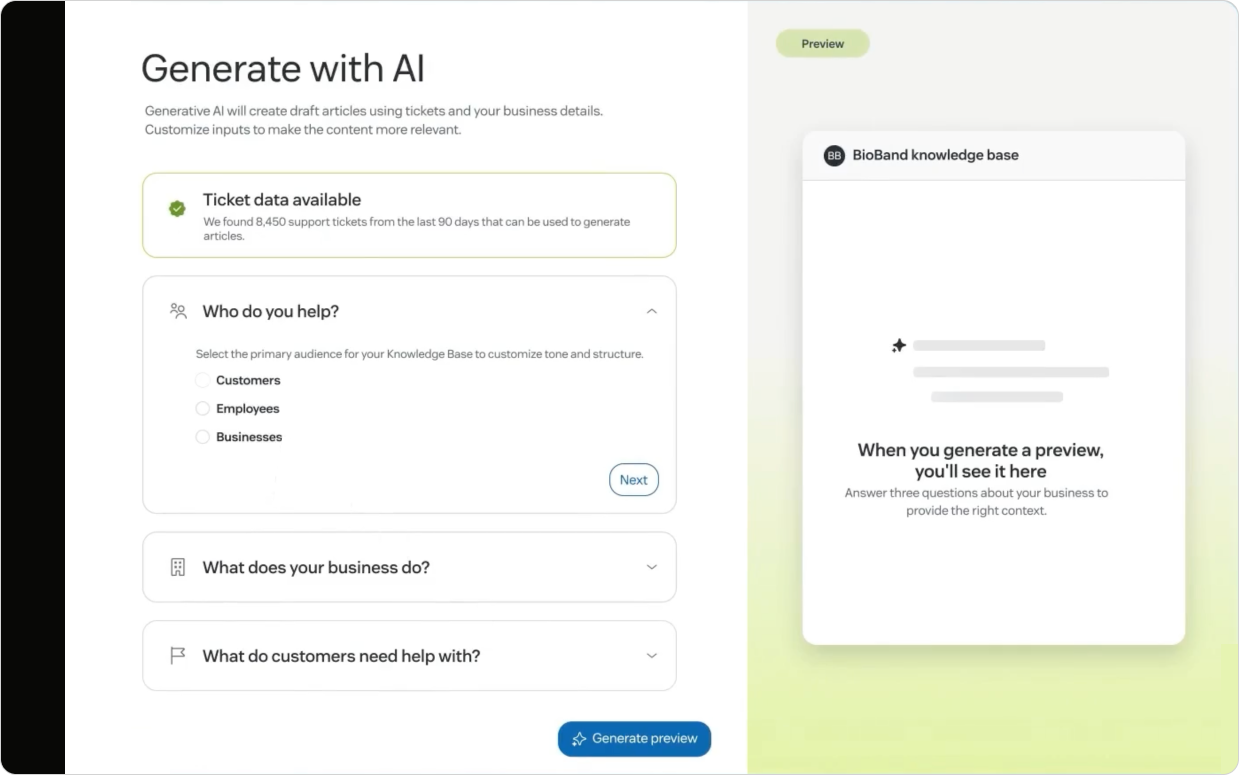
This is where the new Knowledge Builder comes in. It indexes your existing support articles and uses that content in combination with information about your company like target audience, type of company and issue types to generate an entire Help Center for you. It turns conversation content into article drafts, sorts them into sections and categories, and even makes them available in multiple locales. All that's left to do for your team is to validate the content and publish it.
The generated content won't be perfect. You still need your team to read the drafts and correct them where needed. Knowledge Builder turns your team into editors that validate your knowledge, and removes the need to write every article from scratch. Not only is it a massive time saver, it also makes sure that the knowledge hidden in your support tickets visible, increasing your automated resolution rate.
By shifting the workload from writing to validating and instructing—and pairing that with existing AI tools in the Help Center like tone shift, expand, or simplify—it suddenly becomes a lot easier to get knowledge out the door. You can spin up a Help Center faster, surface better answers sooner, and give agents back the time to focus on the requests that can’t be turned into articles.
Knowledge Builder is available in EAP, and will soon be made generally available to all Zendesk customers.
Admin Copilot
The intro to this theme already noted it. AI makes it possible for people who know the processes to deploy them without the need for technical skills or deep knowledge of the platform. It shifts ownership from technical towards operational, allowing those teams and people to have an immediate impact.
But while some team leads might already know what they want to change, it's equally important to get the right insights to know what to modify as your company and support evolves.
This is where the new Admin Copilot comes into play. This service gathers insights from your Zendesk environment and offers a clear overview in Admin Center of what's going on in your instance. It offers suggestions to improve your setup, with options like modifying views, changing routing rules or adding and changing your triggers.
These changes can be approved as-is, or you can instruct Admin Copilot to tweak the suggestions before deploying them. You can even use it to describe changes you want to make and Admin Copilot will list implementation steps. You can talk to the Copilot to further tweak the changes, and deploy them from within that conversation.
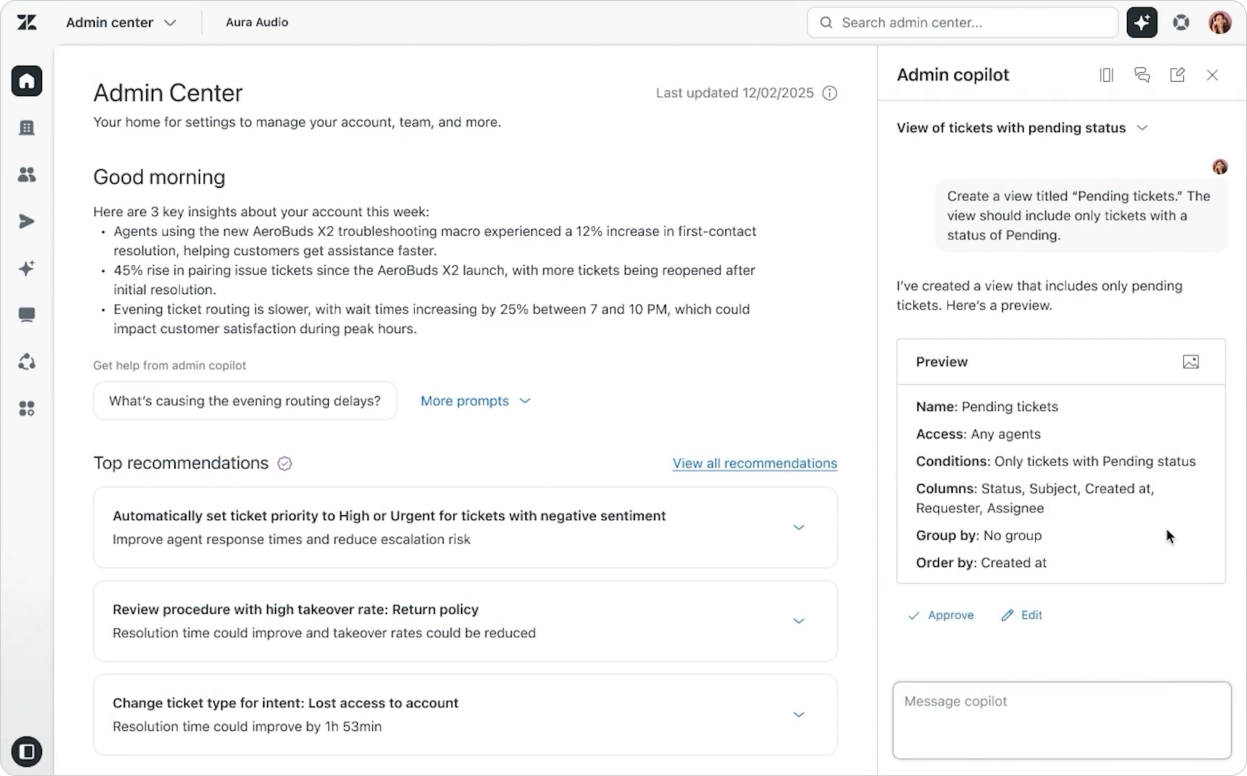
When I first saw this new feature I immediately had two reactions. For one, this is a Zendesk Consultant in a box. And secondly, how does this scale?
Let's start with the first one. I used to be a Zendesk consultant (well, technically I'm still one for the next week..) and a big part of the job is turning customer processes into triggers, views and automations. If this tool can do that for the customer, and offer Team Leads up-to-date insights on what's going on, that basically makes that job unnecessary. And that's great. If team leads can just talk to the Admin Copilot and suggest changes, that's a use efficiency gain, and empowers them to act and own their Zendesk environment.
But that brings me to my second reaction. How does this scale?
We all know those Zendesk environments with trigger configurations from hell. Dozens, if not hundreds of triggers configured to handle unique scenarios without a clear approach or without any rhyme or reason. When (not if) tickets start behaving weird, finding out why a certain tag got added becomes a treasure hunt across all these triggers.
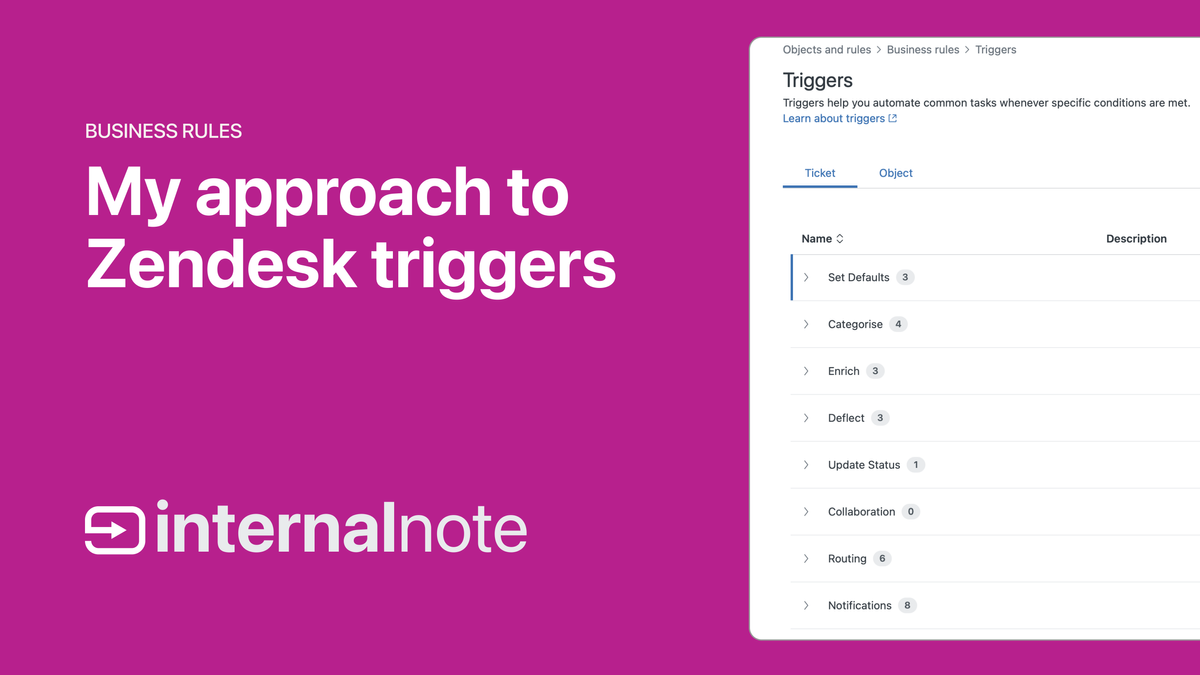
Looking at the suggestions the Admin Copilot makes, I see this problem already occurring at a limited scale. If suggestions get added as new triggers without taking the overall picture in account, you might run the risk of ending up with hundreds of purpose-built triggers that do not have a cohesive approach, and duplicate a lot of actions across each one of them. If those triggers then conflict, team leads might be tempted to add new triggers to fix the issue, making the problem bigger and bigger.
So I really hope Admin Copilot will have some sort of refactoring built-in. A way to take the entire trigger list into account and make suggestions based on the entirety of the setup. But from my experience on how GitHub Copilot or OpenAI Codex work when it comes to writing code. I assume the entirety of the environment might be too big for its context window, similar to how GitHub Copilot also has a tendency to write very fractured code (at least when I use it).
But overall, I really like this new approach. It leverages the same instructive capabilities we already use for customers and agents and gives them to Zendesk Admins. Can't wait to play around with this when the EAP goes live in November!
HyperArc
The announcements at this AI Summit really span the entirety of the Zendesk platform. Knowledge Builder takes care of ticket deflection. HyperArc handles the other end of the ticket lifecycle.
Building reports and getting insights used to be a manual job that requires deep knowledge of analytics tools. Not for lack of trying, but even I lack the skills to build a proper dashboard in Explore (Analytics) and often resort to ChatGPT to ask for help when I need to do so.
Zendesk's prebuilt dashboards already offer a good overview of what's going on in your instance. For most customers they offer a lot of insights already, but by being prebuilt they do lack the unique context of your company.
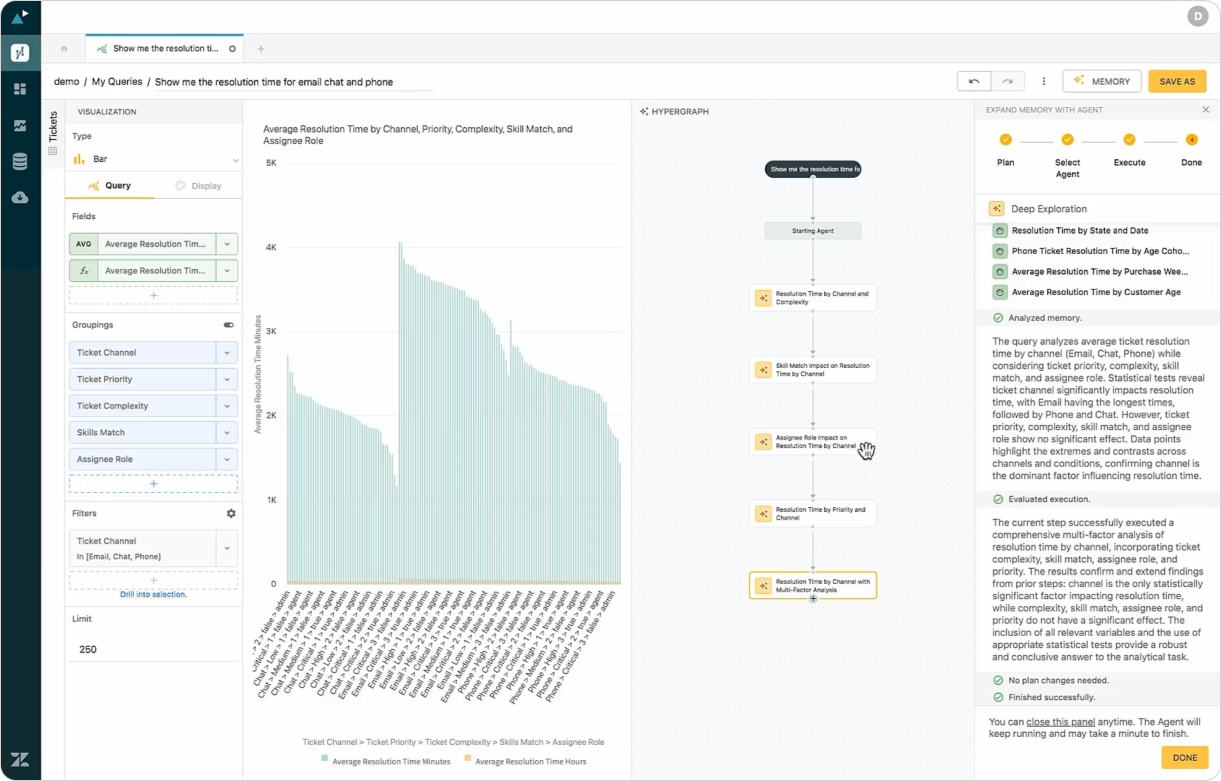
HyperArc, a recent acquisition from Zendesk tries to solve both issues. Similar to Admin Copilot it uses a conversational agent you can talk to and ask for insights. HyperArc will render reports, show trends and explain what's happening, giving you a data analyst at your fingertips.
By being conversational in nature it makes it possible for the person that needs the data to just ask for it. HyperArc will follow these instructions and return the results, without the need to actually build the reports yourself.
Secondly, since it uses your entire ticket history as context, the data is highly custom to your environment, shifting away from prebuilt dashboard towards fully custom reports, giving you exact insights in your environment and situation.

Widening the platform
So far we've talked about the way Zendesk is leveraging its AI Agents to offer resolutions across channels. Its platform spans the entire ticket lifecycle from creation up to interacting with your entire company. And it's leveraging AI to shift from building towards instructing, making Zendesk easier to configure and deploy for your teams.
But while I've used customer service as the prime use case across this article, Zendesk is actually more than just a tool to interact with customers. Launched at Relate earlier this year is Zendesk's new Employee Service Suite, a new SKU that focuses on HR and IT teams offering support to your own employees.
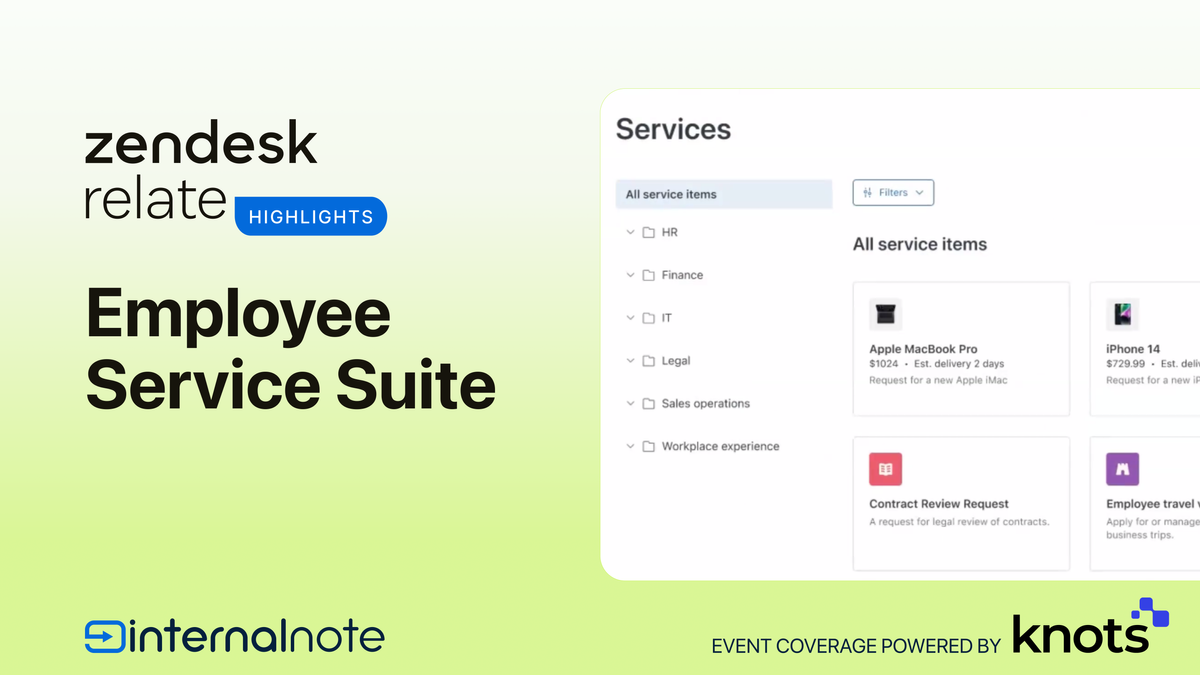
Following that announcement we already saw the release of the new Approvals and Service Catalog features. The new department spaces make it easier to guarantee privacy across teams, and new changes like the cross-brand request list, brand permissions, and improvements to messaging authentication make the Zendesk Suite more powerful and capable in these scenarios.

At the core of the new Employee Suite lies Custom Objects. Custom Objects are the basis for the new approval and service catalog and allow you to add any kind of structured data to Zendesk. Where Zendesk comes out of the box with users, organizations and tickets, they allow you to add orders, products, assets, locations, work orders or bookings. Agents can see that data right next to tickets, giving them richer data and more context without the need for external platforms or tools.
Employee Service Suite is just one example of how Zendesk is expanding its platform to serve new audiences and industries.
The newly acquired Local Measure powers its new Contact Center capabilities, allowing it to offer a powerful new voice channel to companies that have outgrown Zendesk Voice. Contact Center offers more powerful routing options, deeper insights and more advanced automation options, allowing these large enterprises and BPOs to automate their large influx of calls while keeping those interactions within the same platform that also takes care of their conversations and tickets.
And while Zendesk is adding new reporting capabilities with HyperArc, powerful AI Agents with Ultimate, better insights with Klaus and a more capable telephony solution with Local Measure, it's also shedding some weight. It's deprecating Zendesk Sell, removing a distraction that caters to the CRM and sales automation market, and reaffirming its focus on solving the service problem for both customers and employees.
IT Asset Management
One of the core use cases for Employee Service is asset management. Onboarding new employees or managing IT support tickets requires knowledge of what devices are assigned to an employee. Your IT team needs to know what devices are available, on loan or being repaired.
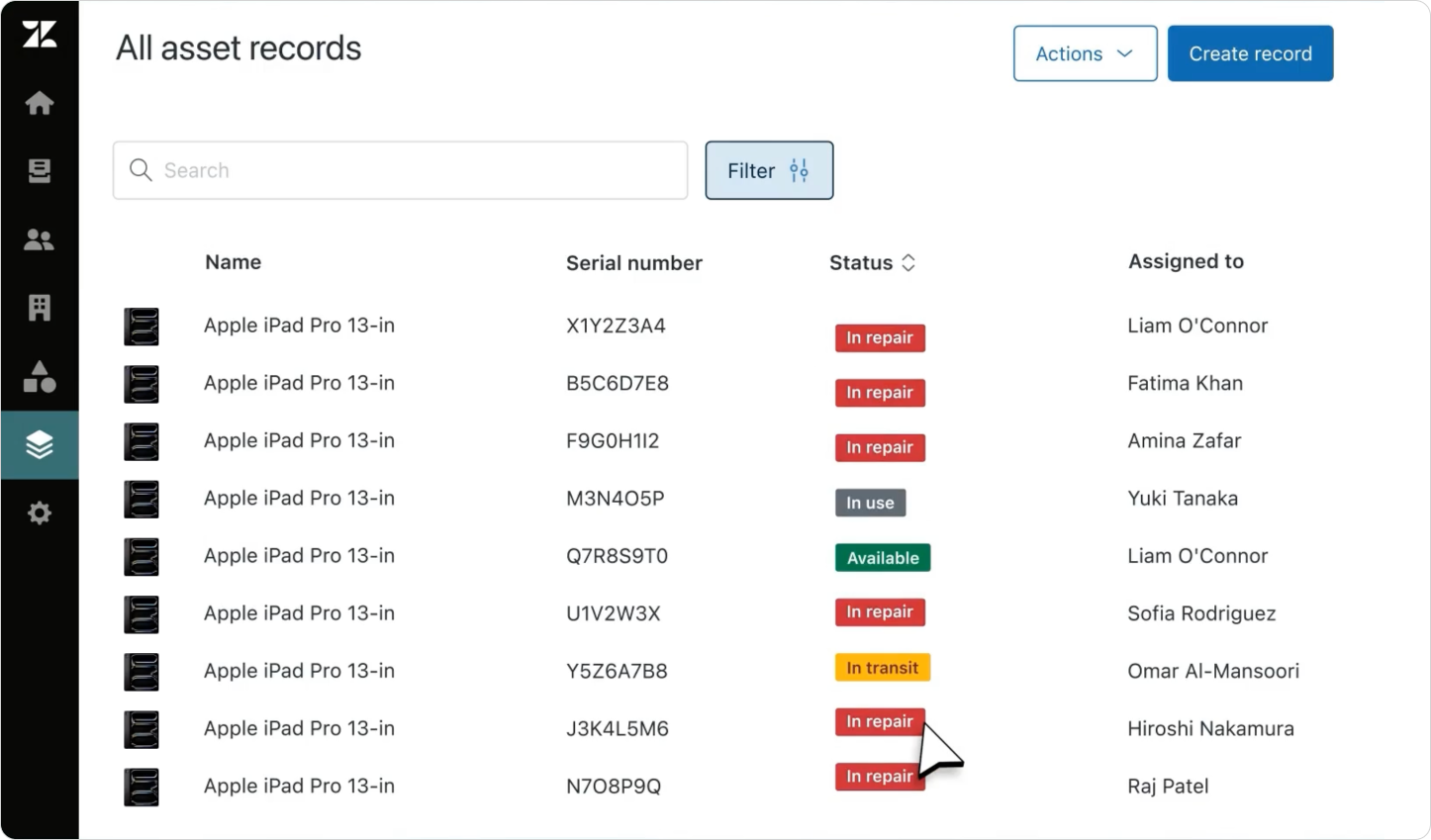
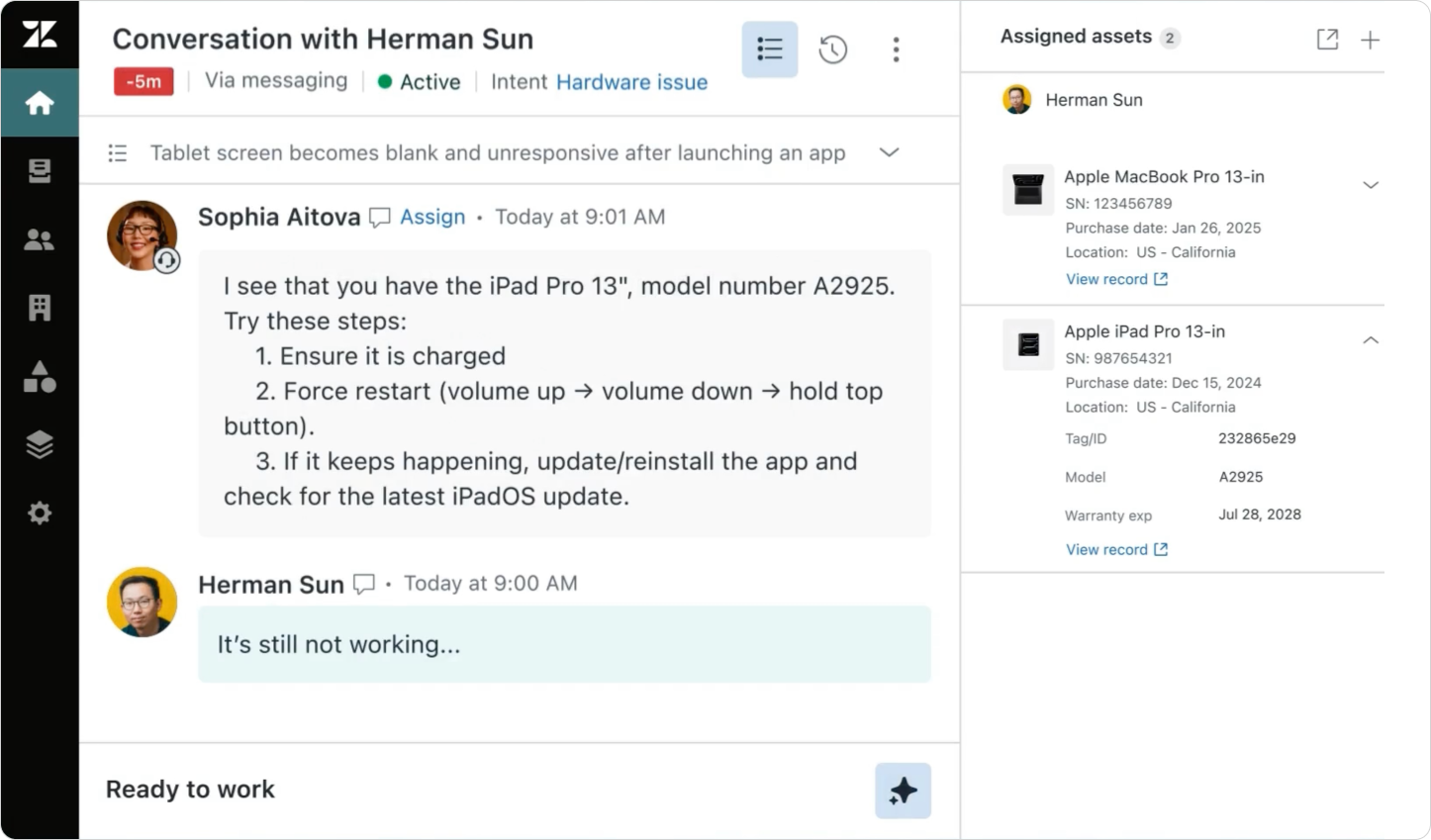
The new IT Asset Manager
Similar to how the Service Catalog is a more powerful version of forms and lookup fields, this new asset manager allows you to import all your IT assets into Zendesk and manage them within the platform in a more capable version of Custom Objects.
Each device can have custom fields storing device and assignment data. You can filter your assets, link them to users and tickets, and manage the entire device lifecycle from within Zendesk, deeply integrated with reporting and the service catalog.
The IT Asset Manager will be available in EAP later this year.
Video Calling and Screen-Sharing
Zendesk started as an email-based ticketing system. It added voice, chat and social messaging channels and grew into a real omnichannel solution over time. But as AI Agents and automation offer more and more immediate support to customers, sometimes being able to talk to the customer and actually see what they're doing is still the best way to give support.
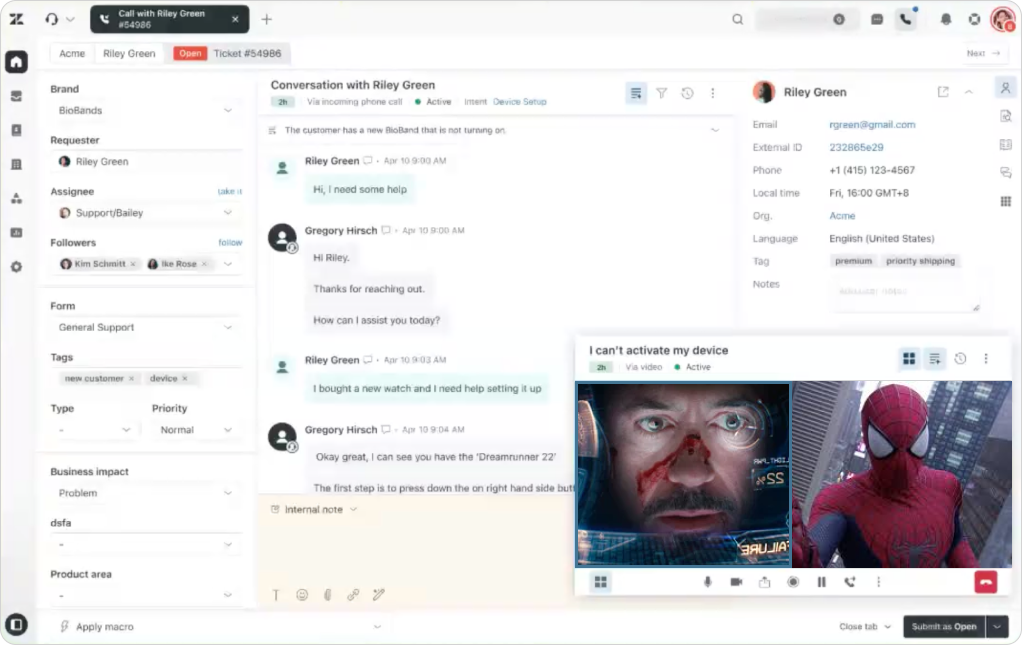
And while a direct conversation with the customer is not scalable to do for every customer, as more and more interactions are fully automated, those automations do free up time for agents to work on those unique, highly personal tickets. It's a bit of a theme across this article, and this last new feature wraps it up nicely.
Newly announced at the AI Summit are Zendesk's new video calling and screen-sharing capabilities. It allows agents to reach out to customers and start a video call. Customers can optionally share their screen, and agents can follow along and guide the customer toward a solution. Pretty awesome, right?

Resolutions for All
Zendesk Relate kicked off 2025 with the Resolution Platform. A reframing of the Zendesk Omnichannel story into a clear focus: this platform helps you to resolve customer questions.
The AI Summit is a clear Act II to this story. Every element of the platform got an upgrade pushing the platform forward towards that goal.
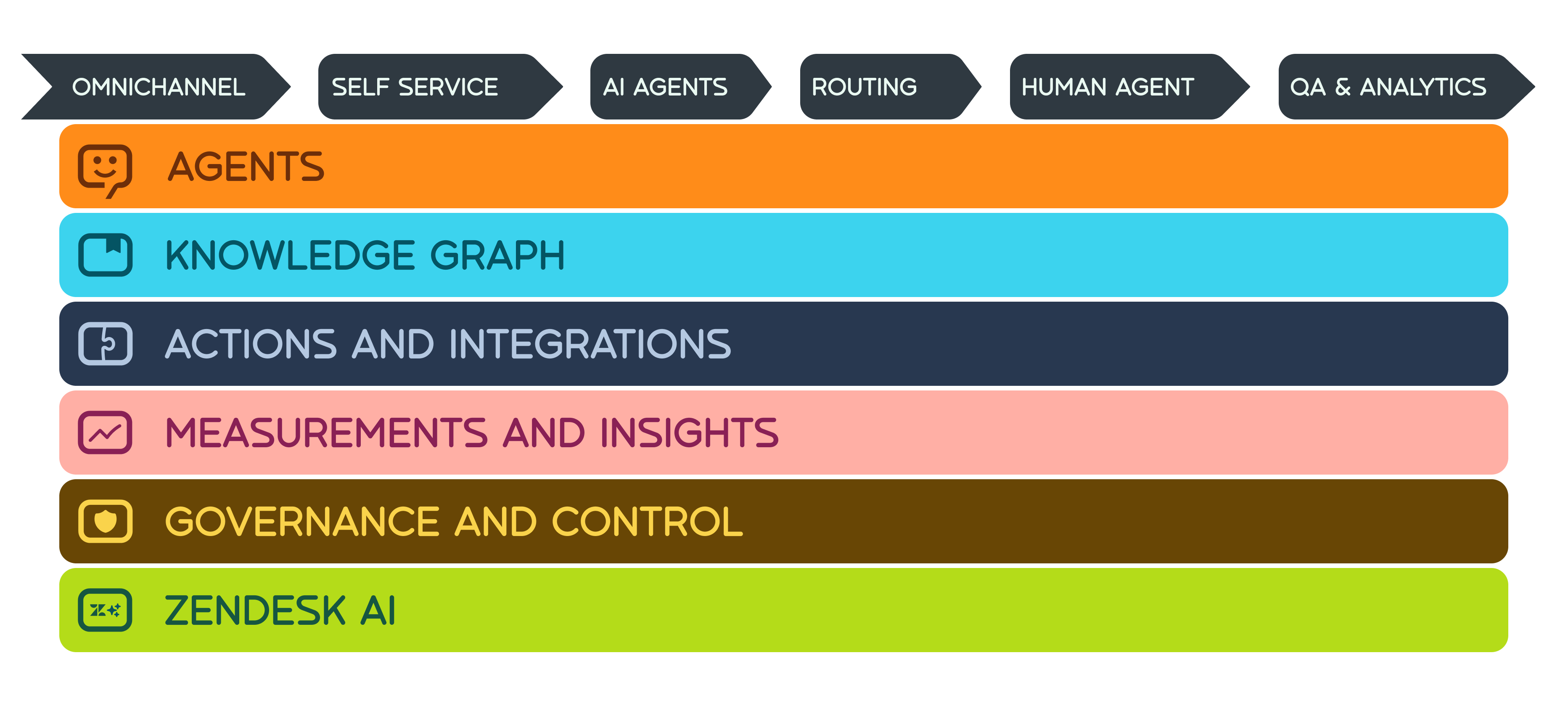
AI Agents and Agent Copilot got a new channel with Voice. Knowledge Graph got new connectors and the AI-powered knowledge builder. Actions and integrations gained new Action Builder capabilities. The new HyperArc acquisition and live data monitoring empowers measurement and insights. And the new Admin Copilot gives new control to your admins and team leads.
Overall this was a great keynote. There was a clear overall story, the smart watch framing made the announcements understandable by using them in clear examples and the presentation wasn't overly technical.
The breakout sessions did go into plenty of detail, so be sure to watch them if you have the time.
If I do have to add one piece of criticism: from all the announcements made today, the ones I can actually test and use today are few. Most of the capabilities shown are still in EAP, or will be made available as such in the future.
But knowing Zendesk, and looking at their releases of the last few years, come Relate 2026 most of what we've seen today will be available. And while we're waiting for these new capabilities to go live, take a look at the releases of the last year. I bet you there's still some great features you're not using yet.
So my advice? Take a look at Omnichannel Routing, deploy Zendesk QA, and explore Generative Replies for your AI Agents. If you want to start automating your resolutions, you're going to need these features!





